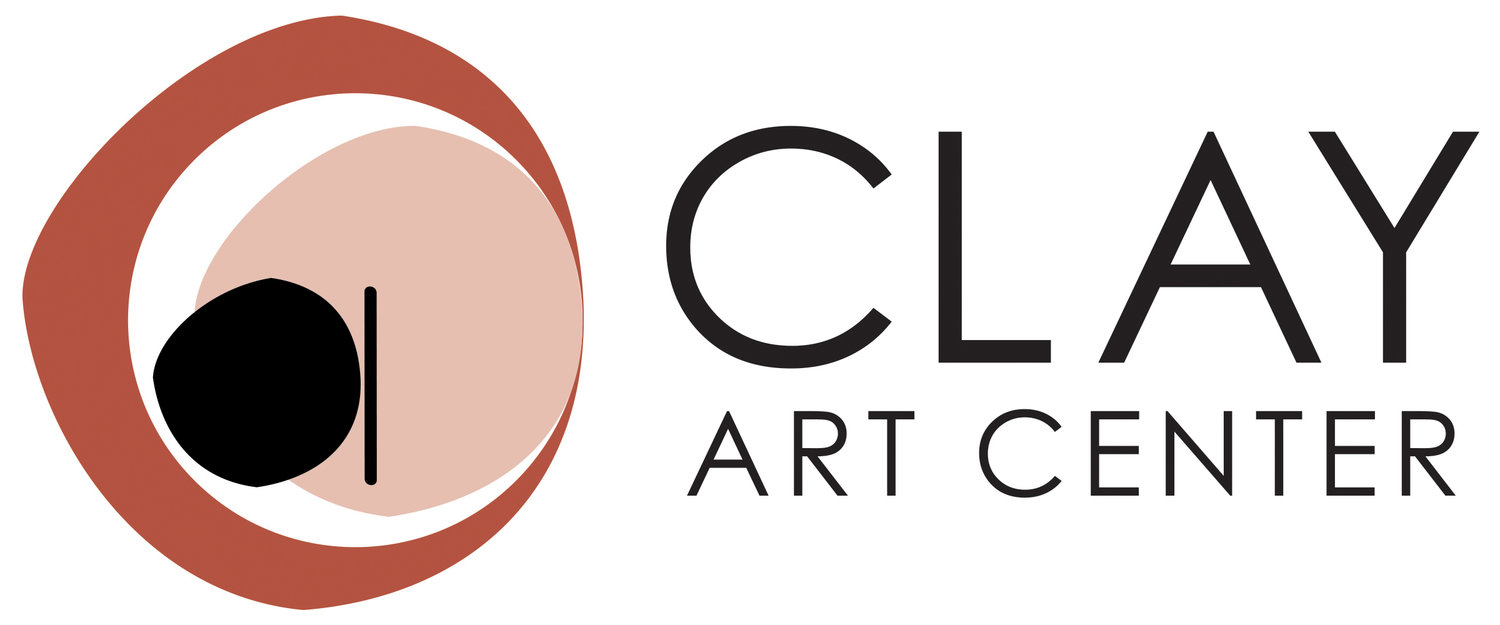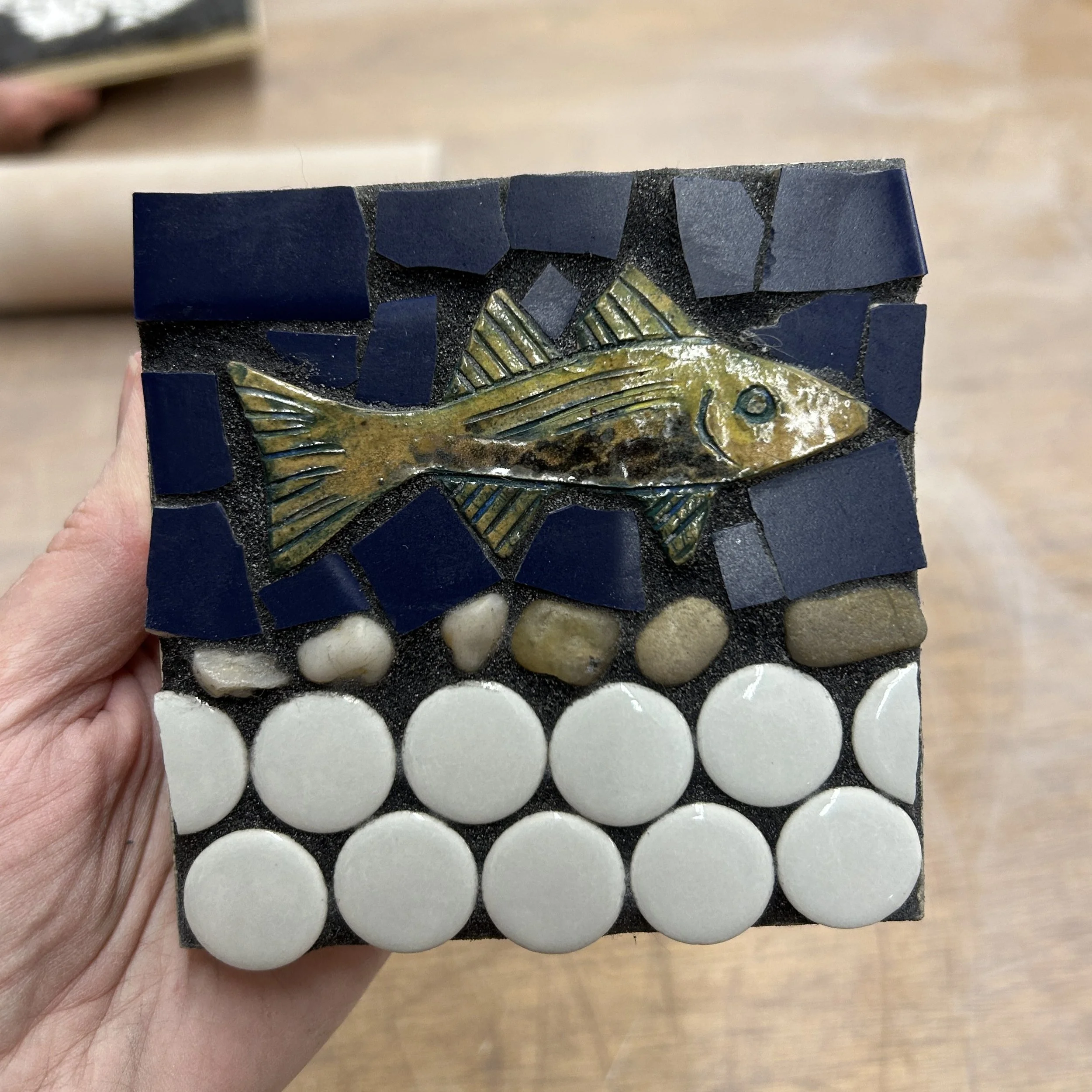Tips & Techniques: Combining Ceramic and Non-Ceramic Elements
Clay Art Center staff members Brian Barry and Regina Farrell-Fagan share their tips and techniques for creating projects that incorporate non-ceramic materials.
Clay is beloved for its endless creative possibilities: both malleable and strong, ceramic work can take just about any shape or form, making it the perfect vehicle for self-expression. When planning their projects, ceramicists have to keep many factors in mind, including shrinkage rates, delicate joins, and the interaction between clay body and glaze. For artists who choose to incorporate non-ceramic materials into their work, the factoring can become even trickier. Two Clay Art Center staff members, Brian Barry and Regina Farrell-Fagan, share their tips below for combining clay and anything else into a single project.
From Brian Barry, Community Arts & Offsite Programs Manager
Q: When did you begin working with clay? What drew you to it as a medium?
I started working with clay in June 2024, as soon as I started in my role as Program Manager, Community Arts and Offsite. I was drawn to Clay Art Center as much as I was the medium of clay. As a Port Chester resident, my first interaction with Clay Art Center was at the 2023 Port Chester Arts Festival. I glazed a vase for the raku firing in the parking lot and fell in love with the unpredictability of the final product and the community atmosphere. I also think there’s something about ceramic’s functionality that makes entering a fine arts space less intimidating. I studied languages at Bennington College, where most students study visual arts, but I never felt like I belonged in spaces with artists.
Q: When did you first begin making work with non-ceramic components?
My first project that included non-ceramic components was in August 2024. I created a wooden signpost with 9 ceramic tiles for my husband’s birthday. Each tile represents a place that’s important to us. I had a lot of guidance from our studio manager, August, with the construction of the wooden sign post. The students in Independent Study, teachers, and staff guided the construction of the ceramic tiles and underglaze transfers.
Q: How do you conceive of a project with non-ceramic components differently than one that is entirely made of clay?
As a student in weekly ceramic classes, I know how much I have to learn and improve upon. When throwing on the wheel for a project that is entirely made out of clay, I allow myself to focus more on the process of making and give myself grace. If I’m making a mug, for instance, I might not care if the mug is 5” tall or 5.5” tall–as long as the walls are even! When conceiving projects with non-ceramic components, I need to be more precise with measurements to make sure the non-ceramic components will fit after the piece is glaze fired.
Q: What are your top three tips or strategies for combining clay with other materials?
Embrace trial and error! Often, the first time I try to make something, I fail, but the failure informs my next attempt.
Get a shrink ruler! Shrink rulers are great because they help you figure out how large a piece needs to be when wet to ensure it fits with any non-ceramic components after firing.
Timing is everything! When adding high-fire wire for earrings or ornaments, making sure the clay is in the right stage of dryness is very important. If the clay is too soft, the wire might not stay in place and may poke through the clay. If it’s too dry, it’ll chip or break the piece.
Q: What advice would you give to someone who is nervous about embarking on their first project with non-ceramic components?
A healthy dose of nerves can be good if it makes you more careful and intentional about the project you’re doing. Think about what you’d like to make that you can’t just make with ceramics (coasters, ornaments, pendants, etc.) and just get started! I often find inspiration for projects with non-ceramic components by looking at the hardware you can buy on ceramics websites.
Q: What project do you have next on the horizon?
I’m working on a few projects that have non-ceramic components– soap dispensers, a hummingbird feeder, and a honey jar with a honey dipper stick.
From Regina Farrell-Fagan, Director of Exhibitions & Marketing
Q: When did you begin working with clay? What drew you to it as a medium?
I first worked with clay in Ireland as a child in a very natural way. I loved to make little animals from clay straight from the garden, and I would leave them in the sun to bake. I was extraordinarily proud of a hedgehog that I made once! When I was in my early 20s I took clay classes at two different locations: I made pinch pots and took part in a pit firing during my fine art studies at college in Galway, and loved it so much I went on to take classes at a local pottery studio where I also explored clay sculpture. Later I studied sculpture at the Art Student's League of New York, learning casting along the way, and I then went on to major in ceramics at Lehman College. When I ran my own teaching studio in the Bronx after graduating, I made clay classes available to my local community and shared my passion.
Clay is a very intuitive medium and offers infinite possibilities. Unlike drawing and painting, you can have little to no artistic training and still make something you love in clay. In that sense it is less frustrating, although I'm not sure potters would agree! I think clay is also one of the most therapeutic art mediums one can work with, and really helps us reconnect with the earth we love.
Q: When did you first begin making work with non-ceramic components?
I first explored using non-ceramic components with clay through mosaic making. Mosaics offer the opportunity to use clay in a very design-focused way with making custom tiles, textures, and patterns, but incorporating items like pebbles, shells, glass, or beads can really help expand the work and make it even more exciting and creative. I often add small pebbles to my pieces to give the eye a different form of visual stimulation, and a contrast in texture and rhythm in the work. There are challenges with grouting the pebbles or stones, but the end result is beautiful. Seaglass is also another great non-ceramic component to add to a mosaic. The trick with making these types of mosaics successful is not allowing the non-ceramic items to overpower the clay components. By making clay the primary material, non-ceramic components become the supporting act to the versatility and beauty of clay.
Q: How do you conceive of a project with non-ceramic components differently than one that is entirely made of clay?
When choosing non-ceramic components the first thing you need to think about is how the piece will adhere to the supporting surface of the mosaic. Organic non-ceramic material like pebbles and shells will do great, but plastic items such as chunky beads may not stay in place over a long period of time. All the materials in mosaics have different expansion rates in heat and cold, and this causes things to be less secure over time. Ceramic and glass components do well, other materials can disintegrate or come away from the piece altogether much quicker than the surrounding materials. Having said this, you shouldn't hesitate to try new materials! Make smaller test pieces before you commit to a big project. Consider whether it is an indoor or outdoor work, and choose materials accordingly. For example, don't add wood pieces to a mosaic that will ultimately be outdoors, since wood will expand in wet weather and eventually fall off or erode.
Q: What project do you have next on the horizon?
I always enjoy making the demo pieces for the mosaic workshop I teach at Clay Art Center, it forces me to make and the deadline means I have no excuses! I have a low wall on my patio that I keep eyeing for a mosaic install. I'd love to sit there in the sun and enjoy something unique that shows my love for clay and for mosaics! I would definitely combine some stones and pebbles in there too. It's one of many home projects on a very long list!








